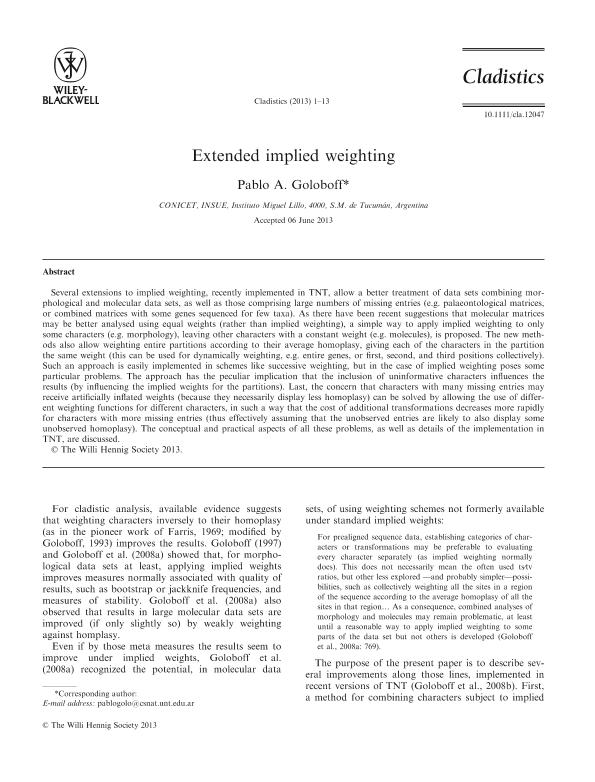Mostrar el registro sencillo del ítem
dc.contributor.author
Goloboff, Pablo Augusto

dc.date.available
2017-12-11T21:13:10Z
dc.date.issued
2013-07
dc.identifier.citation
Goloboff, Pablo Augusto; Extended implied weighting; Wiley; Cladistics; 30; 3; 7-2013; 260-272
dc.identifier.issn
0748-3007
dc.identifier.uri
http://hdl.handle.net/11336/30201
dc.description.abstract
Several extensions to implied weighting, recently implemented in TNT, allow a better treatment of data sets combining morphological and molecular data sets, as well as those comprising large numbers of missing entries (e.g. palaeontological matrices, or combined matrices with some genes sequenced for few taxa). As there have been recent suggestions that molecular matrices may be better analysed using equal weights (rather than implied weighting), a simple way to apply implied weighting to only some characters (e.g. morphology), leaving other characters with a constant weight (e.g. molecules), is proposed. The new methods also allow weighting entire partitions according to their average homoplasy, giving each of the characters in the partition the same weight (this can be used for dynamically weighting, e.g. entire genes, or first, second, and third positions collectively). Such an approach is easily implemented in schemes like successive weighting, but in the case of implied weighting poses some particular problems. The approach has the peculiar implication that the inclusion of uninformative characters influences the results (by influencing the implied weights for the partitions). Last, the concern that characters with many missing entries may receive artificially inflated weights (because they necessarily display less homoplasy) can be solved by allowing the use of different weighting functions for different characters, in such a way that the cost of additional transformations decreases more rapidly for characters with more missing entries (thus effectively assuming that the unobserved entries are likely to also display some unobserved homoplasy). The conceptual and practical aspects of all these problems, as well as details of the implementation in TNT, are discussed.
dc.format
application/pdf
dc.language.iso
eng
dc.publisher
Wiley

dc.rights
info:eu-repo/semantics/openAccess
dc.rights.uri
https://creativecommons.org/licenses/by-nc-sa/2.5/ar/
dc.subject
Weighting
dc.subject
Parsimony
dc.subject
Cladistics
dc.subject.classification
Otras Ciencias Biológicas

dc.subject.classification
Ciencias Biológicas

dc.subject.classification
CIENCIAS NATURALES Y EXACTAS

dc.title
Extended implied weighting
dc.type
info:eu-repo/semantics/article
dc.type
info:ar-repo/semantics/artículo
dc.type
info:eu-repo/semantics/publishedVersion
dc.date.updated
2017-12-11T19:41:30Z
dc.journal.volume
30
dc.journal.number
3
dc.journal.pagination
260-272
dc.journal.pais
Estados Unidos

dc.journal.ciudad
Hoboken
dc.description.fil
Fil: Goloboff, Pablo Augusto. Consejo Nacional de Investigaciones Científicas y Técnicas; Argentina. Universidad Nacional de Tucumán. Facultad de Ciencias Naturales e Instituto Miguel Lillo. Instituto Superior de Entomología; Argentina
dc.journal.title
Cladistics

dc.relation.alternativeid
info:eu-repo/semantics/altIdentifier/doi/http://dx.doi.org/10.1111/cla.12047
dc.relation.alternativeid
info:eu-repo/semantics/altIdentifier/url/http://onlinelibrary.wiley.com/doi/10.1111/cla.12047/abstract
Archivos asociados
